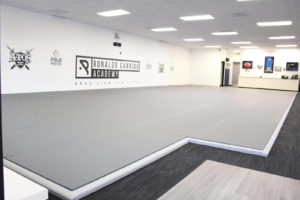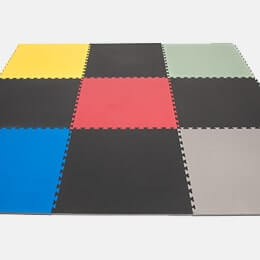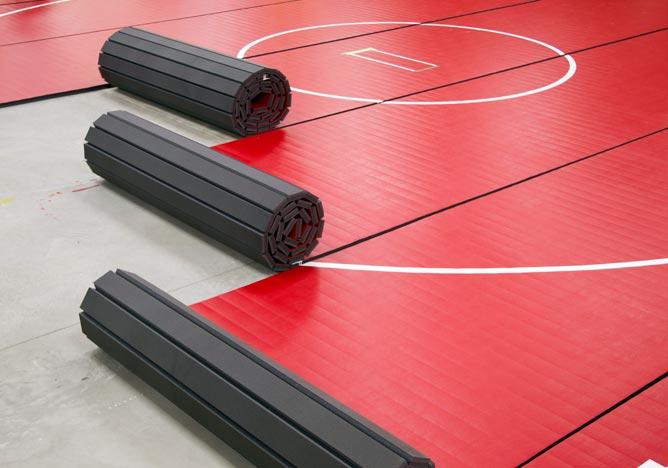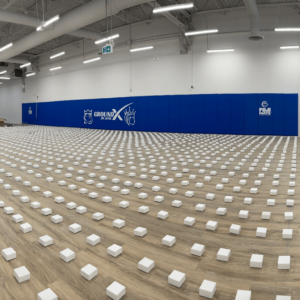Brazilian Jiu-Jitsu students spend most of their time on the mats so what they train on is important for their health and longevity. I have trained on a ton of different surfaces from wrestling and gymnastics mats, home setups and Brazilian Jiu-Jitsu academy setups. The main suppliers of mats are Fuji, Zebra, Swain/Dollamur.

Home Gym Setups
For home gym setups, probably the cheapest starting place is puzzle mats. These interlocking pieces can be locked together and are light weight and easy to throw down. You can get these at home depot for about $2 per square foot. They are going to be better than training on carpet, but you will quickly want to graduate out of those. They can be useful if you have them around for other purposes like your child’s playroom already. I am almost a little bit surprised that Zebra Mats https://zebraathletics.com/product/1-zebra-puzzle-mats/. There are still tournaments in Brazil that are held on puzzle mats. These usually have a very short warranty of 90 days.

Roll Out Mats
In the middle ground between home gym and professional gyms are rollout mats. You will find these in a lot of home gym setups and they are easier to setup at regional tournaments. They are lightweight, give decent protection. You can easily carry at 6′ by 10″ section on your shoulder. So this is where I would tell people to start with their home gyms. Usually the seems can be velcro’d or mat taped together so the install is quick and easy. I am surprised to see how often these are installed in permanent flooring situations at Brazilian Jiu-Jitsu academies because real tatami mats have been shown to have vastly superior impact protection, but they are lightweight, easy to install and while about double the price of puzzle mats, they are cheaper than tatami mats at about $4.50 per square foot (with usually cheaper shipping as well). Generally you get a warranty between 6 months and 5 years depending on the supplier which should give you an idea that they last about half as long as tatami mats (10 years).

Tatami mats
At the professional level of mat setups the best you can get is tatami mats. These mats offer 6x the protection from throws as roll out mats and come with the longest warranty (often as high as 10 years). So if these mats are the best in class, what are the downsides for one is the cost usually coming around $6.25 per square foot plus higher shipping costs (generally freight) because of they weigh about 45 lbs per mat (about 21.5 square feet). If you are getting a large amount of these you will want to pay for a lift gate since they have to carried off vertically to avoid damaging the mats. They are difficult to move around, you have to compress them tight at about .25″ per square foot so you need to build a frame of some sort around them (there are frame kits available) or you can do your own with wood. Otherwise they will move around and injuries can occur if a toe gets stuck in the crack. Plus if they aren’t tight, it will be difficult to keep them clean. If you have a odd shaped size, cutting these down is a bit of a pain as well. So best in class impact protection, but heavier, more expensive and cumbersome.
TLDR: Home gym should go probably with roll out mats, academies should go with tatami mats.
Surfaces
There are 2 main surfaces for tatami, Smooth and traditional tatami which is a raised surface. The traditional tatami is what is used on for competition, but I think it is too hard on most beginners’ feet. BJJ is hard enough without having bloody feet to start with so I prefer the smooth. I find the smooth surface actually grippier as well and new tatami are pretty slick to be honest.
Subfloors
So to take your training and safety up a notch you can put a subfloor underneath for even greater impact protection. As a 200 lb athlete I don’t want to do many takedowns on a surface without a subfloor. While we don’t compete on a subfloor, training without one is going to increase injuries and make you not eager to do takedowns.
From a home gym perspective the first thing to think about is using your crappy puzzle mats as a subfloor. You already paid for it so if you decide to upgrade to rollout mats, just put the rollouts over the puzzle mats, it will be better than just the rollout mats. I have never done this and you might need to start framing your mats in so they don’t slide or using some type of a velcro system.
The professional version of the puzzle mats is a sub-mat underlayment pad. These run about $1.20 per square foot and will give you additional protection. Again as a 200 lb individual this isn’t a ton of extra give, but better than nothing under the mats. I only know of one academy that has done this and I wasn’t able to notice a ton of difference.
If you are an academy that started out with rollout mats and then decided to upgrade to tatami (like you should have in the beginning), I would put your tatami over your rollout mats. I know of one academy that has done this and the results are pretty good. Not as good as a true sprung floor, but I don’t mind doing takedowns.
When you really think about subfloor in BJJ you are probably thinking of a sprung floor. The most popular version if the a foam block sprung floor like we have at my academy

These foam blocks are laid underneath multiple layers of osb. The main cost this currently is the osb and the time it takes to install this but probably costs around $3 per square foot for the osb, foam, glue, but not including trim. This style of floating floor was originated in Denver by Jim Carmer. This is my favorite subfloor by far.
The final subfloor is just coming out and seen at my instructor Xande Ribeiro’s academy in Austin, Texas is the a sprung floor with springs. This also features multiple layer of osb over springs. This costs about $9 per square foot. I honestly felt like this was a little too bouncy for my liking, but maybe my opinion will change as I get a chance to train on it more often.
Conclusions
Don’t buy puzzle mats, buy roll outs for home gyms and tatami for professional academies. Tatami are more expensive and difficult to install but worth it for your students. Think about your subfloor! If you mistakenly bought puzzle mats and upgraded to rollouts use them as your subfloor. Or if you bought roll out mats for your academy, then use them as your subfloor for your tatami mats. Best combination is tatami mats over a sprung floor either foam or true springs. Subfloors do mean a lot.
Worst: Puzzle Mats
Okay: Rollout mats or Puzzle Mats + subfloor
Better: Tatami mats or Rollout Mats + sprung subfloor
Best: Tatami mats + sprung subfloor
This is why we went with tatami mats + sprung subfloor and our mats have a smooth texture to them.

